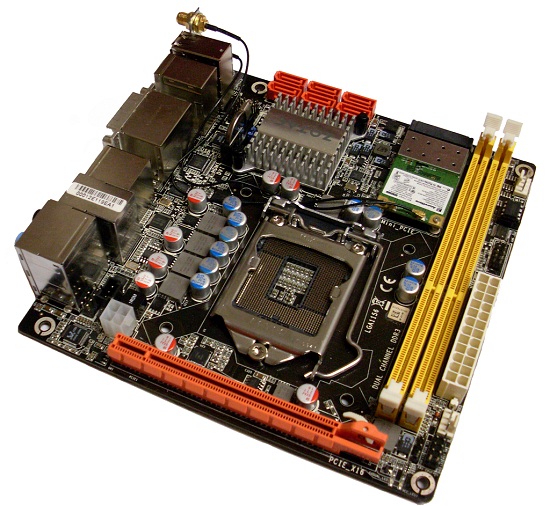Zotac H55-ITX Review - The World's First mini-ITX H55 Motherboard
by Joshua Youngberg on February 28, 2010 12:00 AM EST- Posted in
- Motherboards
For most of us, Zotac isn't the name that comes to mind when thinking about your next motherboard. Instead, brands like ASUS, Gigabyte or MSI are closer to the tip of your tongue. For HTPC users however, that all started to change with the release of several mini-ITX motherboards based on NVIDIA's GeForce 9300 and ION chipsets. Despite its initial teething problems, the Zotac ION ended up being the perfect motherboard for a DIY low powered HTPC capable of full 1080p video playback.
If you needed more CPU power, Zotac offered the LGA-775 socket GeForce 9300-ITX-WiFi. You got the same mini-ITX form factor, but support for Core 2 CPUs instead of the on-board Atom that its ION boards were limited to. With the release of Intel's first 32nm dual-core processors earlier this year, Zotac wanted to offer an updated platform for SFF or HTPC users who didn't want to sacrifice CPU performance. Based on Intel's H55 chipset and supporting the entire line of Core i3, i5 and LGA-1156 i7 CPUs, Zotac sent us its latest mini-ITX board: the H55-ITX WiFi.

There are a couple of possible directions you can take with the H55-ITX. First, you could choose to turn this into a low-watt HTPC by utilizing a Core i3 and relying on Intel’s HD graphics for your video needs. On the other hand, you could install an i5 or i7 and populate the PCIe slot with a dedicated graphics card for a nice mid-range gaming system. Cases such as the Silverstone SG-06 and the upcoming Lian-Li PC-Q08 would complement a system such as this perfectly.
With these two different directions in mind we have decided to test the H55-ITX with both integrated and dedicated graphics. Decide for yourself which direction works the best for you.
On a side note, even the performance computing market is seeing a transition away from the more traditional full-sized motherboards. In fact, ZOTAC markets only one full-sized ATX board in the US.
















69 Comments
View All Comments
Duwelon - Sunday, February 28, 2010 - link
Wrong.GeorgeH - Sunday, February 28, 2010 - link
Actually, very not wrong.After a quick search, it looks like PCP&C 610W is only about 50% efficient at 30-40W (AC power) and about 70% at 70-60W.
This means the DC idle/load wattage numbers on the IGP are ~20W/50W. With a power supply rated at ~85% in that region, the measured power would be ~25W/60W, which is hugely different from the stated 35/76W - 30% "error" on the low end is pretty crappy.
michal1980 - Sunday, February 28, 2010 - link
really? tomshard was able to get idle power down to ~25wattshttp://www.tomshardware.com/reviews/25w-performanc...">http://www.tomshardware.com/reviews/25w-performanc...
now whos wrong?
have an address I have some crows pie to ship you.
mariush - Monday, March 1, 2010 - link
I'd rather use a bigger power supply (possible a Zen 400W passive one) and have the system use 40W instead of using that 220W power supply tom's hardware uses, with a 40 mm NOISY fan, just to get 22W.The difference in watts is so small my cell phone charger eats it when I leave it plugged in over night to charge my phone.
Duwelon - Sunday, February 28, 2010 - link
So efficiency does or doesn't matter with you? Reality shows efficiency is all that matters as long as you have a stable and fairly priced PSU...michal1980 - Sunday, February 28, 2010 - link
efficeny matters. But I doubt that a 610w power supply is very efficent @ 30watts.have you ever heard of the right tool for the job?
mindless1 - Sunday, February 28, 2010 - link
Have you ever heard of gathering more evidence before jumping to conclusions?The purpose is a relative, not necessarily absolute power measurement. Think about it, they are not trying to match every possible system configuration a user could have.
For that, a 610W PSU is fine.
Further, you don't factually know what the right tool for the job is because neither Tom's, nor most reviewers, test long term with minimally sized PSU (that tend to fail prematurely when ran at a higher % of total load rating).
The right tool for the job is not really the most efficient without considering anything else. Think about it, if you really cared about efficiency you would turn off the computer you are using instead to post on the internet!
michal1980 - Sunday, February 28, 2010 - link
what false conclusion? Did you even look at this review?except for the 860 cpu, @ load the system used less then 110watts of power. Using a PSU thats rated 6x that is a waste, on both ends, idle, and peak.
PSU's certified for 80+, have tragets at 20, 50, and 80% of loads. The efficency of most, if not all falls significantly below a 20% load.
a quailty 200W psu would be a much better fit for most systems builds then any 600w psu.
Duwelon - Sunday, February 28, 2010 - link
Have you ever heard of admitting your original statement was wrong to just move on? Thanks for admitting efficiency does matter after your first blunder and then acting like a turd to defend it. No doubt you can find a better PSU, but at least now we know you're smart enough to realize efficiency does matter and you don't think it's pulling 610watts out of the socket or something. Have a nice day.michal1980 - Sunday, February 28, 2010 - link
wrong about what?a 610 watt psu is overkill for a system running ~30-150w.
If you cannot understand that, you are too stupid to even continue this disscussion